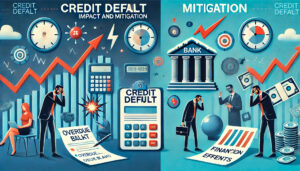Managing high-risk consumer loans effectively involves a strategic blend of thorough credit evaluations, risk-based pricing, and continuous monitoring. Financial institutions must rigorously analyze borrowers’ financial history, credit scores, and income stability to accurately evaluate creditworthiness. Setting appropriate interest rates and credit limits based on these evaluations helps in mitigating potential defaults. Big data can play a crucial role here, enabling detailed insights into spending patterns and providing early warning signals for default risks.
Economic downturns further amplify credit risk due to rising unemployment and reduced incomes. Lenders need to proactively monitor key economic indicators and conduct scenario analysis to predict and mitigate potential losses. Leveraging technology and automation can significantly improve the management process, making risk assessments more accurate and processing times faster. Automation also ensures consistency and fairness in lending decisions, leading to better customer experience and operational efficiency.
Institutions, including peer-to-peer lending platforms, can benefit from adopting robust credit scoring systems and diversified loan portfolios to minimize financial impact. Regulatory policies also play a significant role, imposing stricter control measures that lenders must adhere to. By implementing comprehensive loan policies and strong collection practices, financial institutions can protect their interests and those of their customers, ultimately achieving a balanced and profitable lending environment.
How Can Financial Institutions Effectively Manage High-Risk Consumer Loans?
To effectively manage high-risk consumer loans, you need to follow several strategic steps.
First, you should evaluate the borrower’s creditworthiness by thoroughly analyzing their financial history, credit score, income stability, and other relevant factors. This helps you gauge their ability to repay the loan. Next, use the Five Cs of Credit: Character, Capacity, Capital, Collateral, and Conditions. This profile gives you a better understanding of financial risks and past payment performances.
You should also implement stringent credit risk management practices. This includes setting appropriate interest rates and credit limits, continuously monitoring the loan portfolio, and using AI and data analytics for faster credit risk assessments. It’s crucial to adhere to regulatory compliance like Anti-Money Laundering (AML) and Know Your Customer (KYC) regulations. Identifying high-risk customers by monitoring red flags such as inconsistent information or unusual transaction behaviors is essential.
Develop robust risk mitigation strategies by creating policies, procedures, and systems that effectively handle potential loan defaults. Lastly, regularly update risk assessments to track potential risks and adjust your strategies accordingly.
To wrap things up – by evaluating creditworthiness, using the Five Cs of Credit, implementing stringent practices, adhering to regulations, and continuously updating risk assessments, you can manage high-risk consumer loans effectively and maintain your institution’s stability and profitability.
What Are The Primary Strategies For Mitigating Default Risk In Consumer Lending?
To mitigate default risk in consumer lending, you should adopt several key strategies.
First, conduct a thorough credit assessment. You need to evaluate each borrower’s creditworthiness by analyzing their credit history, current debt load, and income. Utilize the Five Cs of Credit—character, capacity, capital, collateral, and conditions—to get a full picture.
Next, implement risk-based pricing. You should adjust interest rates based on the assessed risk. Higher-risk borrowers must pay higher interest rates to compensate for the added risk.
Use loan covenants to impose conditions that borrowers must adhere to, like maintaining specific financial ratios or limiting additional borrowing. Also, diversify your loan portfolio. Spread your loans across various sectors to reduce exposure to any single borrower or industry, which helps mitigate potential sector-specific issues.
Post-disbursement monitoring is crucial. Continuously monitor the borrower’s financial health after loan disbursement to detect issues early and intervene promptly. Employ credit scoring models and financial analysis tools to predict the likelihood of default, and take necessary precautions.
Finally, consider collateralization. Secure loans with valuable assets from the borrower, which can be claimed in case of default, minimizing potential losses.
In the end, by following these strategies—thorough credit assessment, risk-based pricing, loan covenants, diversification, post-disbursement monitoring, and collateralization—you can significantly reduce default risks and create a healthier lending environment.
How Do Credit Scores Impact The Management Of High-Risk Consumer Loans?
Credit scores significantly impact the management of high-risk consumer loans. Your credit score, a number between 300 and 850, shows lenders how reliable you are based on your financial history.
Lenders use your credit score to decide if they should approve your loan. If you have a high score, you are seen as a low-risk borrower, making it easier for you to get credit with better terms. Conversely, if your score is low, lenders might decline your application or give you a loan with strict conditions and higher interest rates.

Your credit score also affects the interest rates you get. Higher scores lead to lower interest rates, saving you money over time. Lower scores mean higher rates due to the increased risk to the lender.
Additionally, your score influences the terms of the loan. High-risk borrowers might need to provide more collateral or face stricter repayment terms to balance lenders’ risks.
Lenders will assess your credit score along with other factors like your debt-to-income ratio. This helps them set the right price for your loan to manage potential losses from defaults.
For high-risk borrowers, improving your credit score is crucial. You can secure better loan conditions by regularly checking your credit report, correcting inaccuracies, and practicing good credit habits.
As a final point, your credit score plays a vital role in loan approvals, interest rates, and terms. By understanding and improving it, you can access better conditions and reduce borrowing costs.
What Role Does Big Data Play In Assessing High-Risk Consumer Loans?
Big data plays a crucial role in assessing high-risk consumer loans by enhancing risk assessment, providing early warning signals, and improving decision-making speed.
First, big data lets you assess credit risk more accurately by considering diverse factors beyond traditional credit scores and income levels. You can look at payment history, spending patterns, and even social media activity to get a more comprehensive picture of a borrower’s financial behavior.
Next, by continuously monitoring financial activities, big data helps you identify early warning signals of potential defaults. You can detect changes in spending patterns or missed payments, allowing you to intervene proactively before defaults occur.
Finally, big data analytics significantly speeds up your decision-making process. Unlike traditional methods that involve manual data collection and analysis, big data offers you real-time insights, helping you make quicker, data-driven loan approval decisions.
Bringing it all together, big data enhances your ability to manage risk, identify early warning signals, and speed up decision-making, ultimately fostering a more resilient financial system.
How Do Economic Downturns Influence The Credit Risk Of Consumer Loans?
Economic downturns substantially increase the credit risk of consumer loans. When the economy falters, many people lose their jobs or face reduced incomes, making it harder to pay back loans. This leads to more defaults and higher losses for lenders.
You must take steps to manage these increased credit risks during economic downturns. Monitor economic indicators like GDP growth, unemployment, inflation, and interest rates closely. Conduct scenario analyses and stress testing to understand potential losses and adapt your strategies. Review historical data from past downturns to identify patterns and vulnerabilities.
Managing credit risk during these times also means dealing with non-stationary data, where statistical properties change over time. Traditional models may struggle, so you should frequently update them to reflect current conditions. Additionally, reassess your loan grading and modify credit memos to better capture the heightened risks, being more cautious in extending credit and focusing on less impacted sectors.
All things considered, by proactively monitoring the economy and adapting your strategies, you can better safeguard your financial interests.




